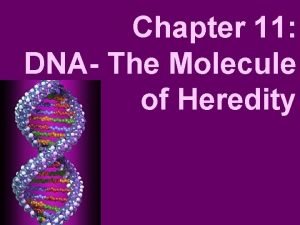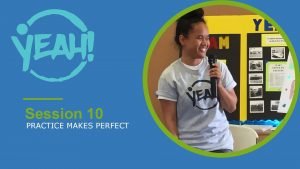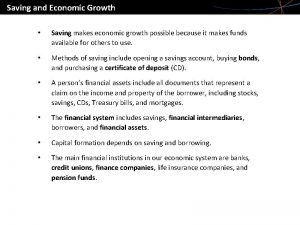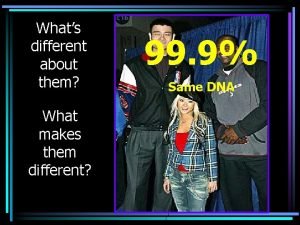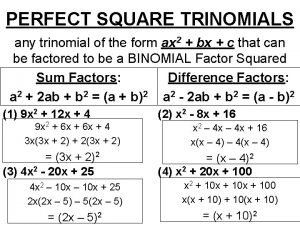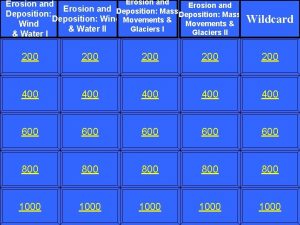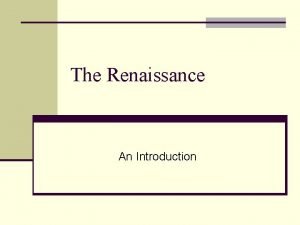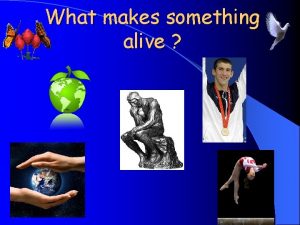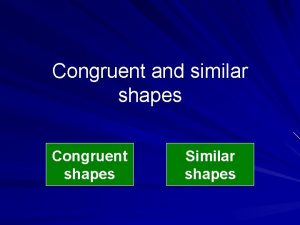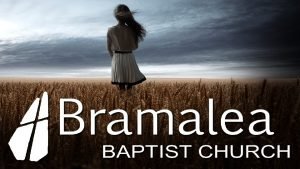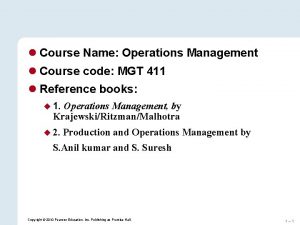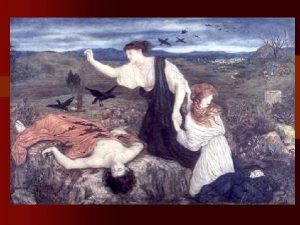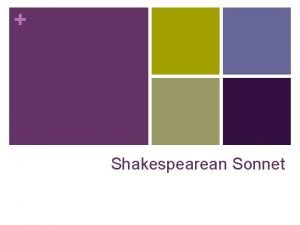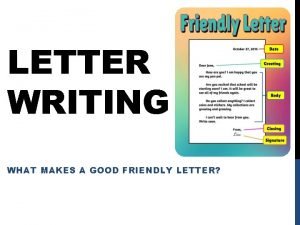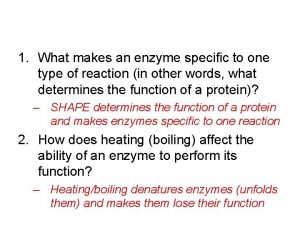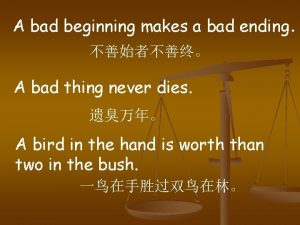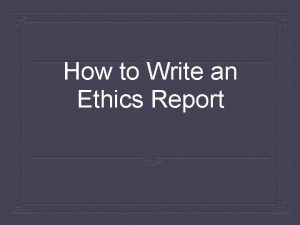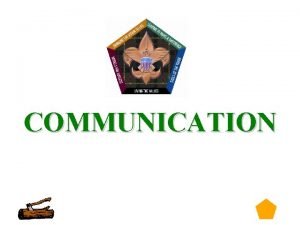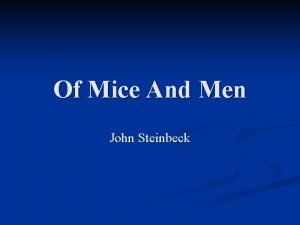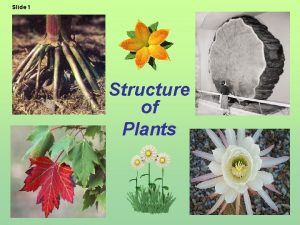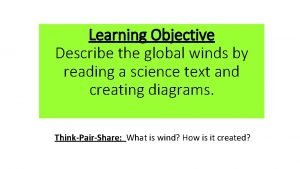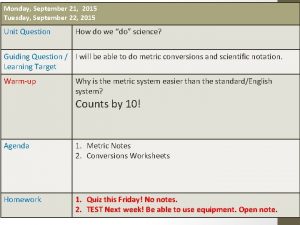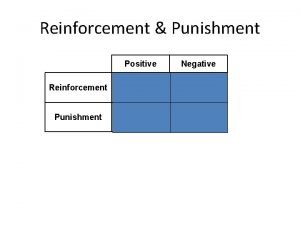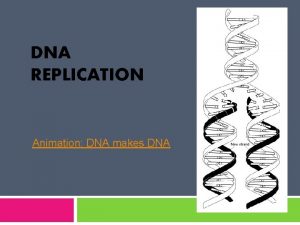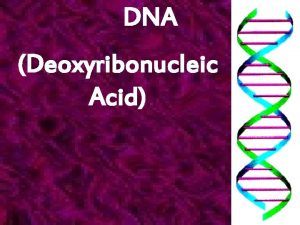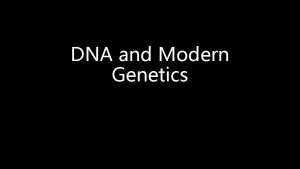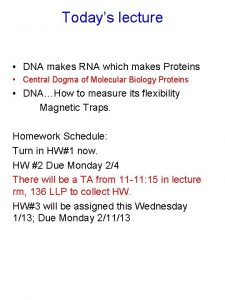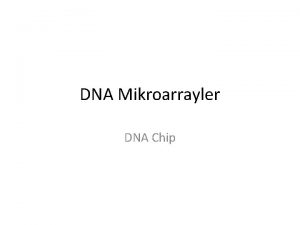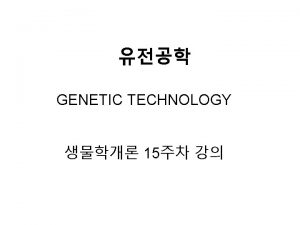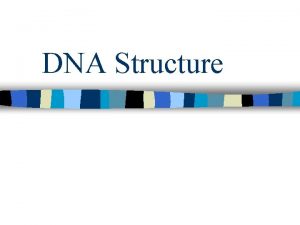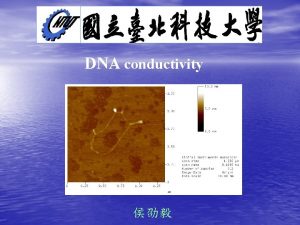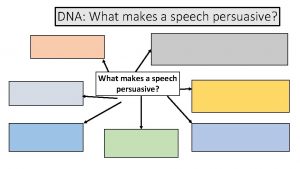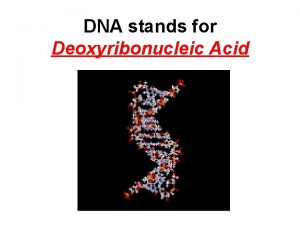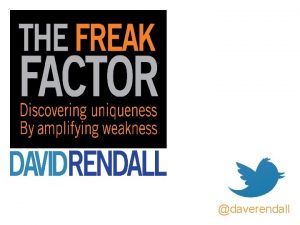DNA What is DNA DNA makes us who








































- Slides: 40

DNA

What is DNA? § DNA makes us who we are § The difference between you, a chimpanzee, a pig, a dog, a plant, or a bacterium is all found in the DNA within these organisms.

I. THE HISTORY OF DNA § After Mendel came up with his ideas of the transmission of the properties of heredity, people were still wondering what the heck was being transferred. § They knew something was being passed down from organism to organism but no one knew what it was.

A. First proof of passing on traits § 1928 - Frederick Griffith § killed one strain of pathogenic bacteria § mixed the dead bacteria with alive nonpathogenic bacteria § some of the harmless strain picked up the pathogenic traits.

Griffith’s Experiment

1. Transformation § He called this “transformation” § This info started a race to find out what caused transformation. § Initially, scientist thought the carrier of that information must be a protein. § So many scientists in many labs spent years taking “pictures” and trying to figure out which protein was the carrier of genetic information.

B. 1940 s: Avery § Determined DNA was hereditary material passed in Griffith’s expt. § Avery’s expt: § § Destroyed lipids transformation happened Destroyed carbs transformation happened Destroyed proteins transformation happened Destoyed DNA no transformation

Avery’s Experiment

C. 1952 Hershey/Chase § Confirmed that genes are made of DNA § Used bacteria and viruses § had virus infect bacteria § Made virus’ protein shell radioactive § New viral shells weren’t radioactive § Made virus’ DNA radioactive § New viral DNA was radioactive

D. 1953 § Scientists knew about DNA but did not know how it was structured. § Rosalind Franklin spent years in a lab doing Xray crystallography (taking pictures with X-rays) § Had great pictures… but didn’t know what they meant § One of her colleagues, Wilkins, showed her pictures to another scientist named Watson without Franklin’s permission.

§ Watson figured out what they meant and was published without giving Franklin credit. § In 1958, Rosalind Franklin died of complications from cancer (probably from all the radiation from her X-ray work). § Watson and Crick won the Nobel prize in 1962 § For figuring out that DNA was a spiral double helix § Rosalind Franklin received no credit.

HW (Answer in complete sentences) § Do you think Franklin was treated fairly in this situation? Why or why not? § If this situation happened today instead of the 1950 s, do you think there would be the same outcome? Explain. § Things to think about: § Similarities or differences in society now vs 1950 s § Differences in news media/ invention of social media § Higher respect of women’s contributions § Higher respect for better-known scientists (Watson and Crick were very well-known and respected, Franklin was not very well known)

II. STRUCTURE OF DNA A. Long thin molecule made of subunits called nucleotides. § Each nucleotide consists of three parts 1. Phosphate group 2. Deoxyribose sugar 3. Nitrogen base § § adenine guanine thymine cytosine.

i. Purine-contains double ring of carbon and nitrogen § adenine and guanine. ii. Pyrimidine-contains a single C/N ring § cytosine and thymine.

B. Two strands of DNA nucleotides C. Each strand is made up of nucleotides bonded between the phosphate of one and the sugar of the next § (Called sugar-phosphate backbone)

D. The nitrogen bases of one strand bond with the complementary bases of the other by hydrogen bonding § This forms a “ladder” with the base pairs forming the “rungs” of the ladder

E. The ladder is twisted into a spiral shape called a double helix

§ DNA molecule resembled a tightly coiled helix and is composed of two chains of nucleotides. § Cratson and Wick came up with the double helix structure of DNA

III. COMPLEMENTARY BASE PAIRS § The base adenine is always paired with thymine § The base cytosine always pairs with guanine. § A always with T § C always with G § EX: GATTACA complement = CTAATGT

Practice: Make the complementary DNA strand for the following: 1. AAA CCC GGG TTT 1. ATG TAC GTT GAC Answers: 1. TTT GGG CCC AAA 2. TAC ATG CAA CTG

IV. DNA REPLICATION § Replication is the process of making a new strand of DNA § All new cells need a complete copy of the DNA in order to function properly

A. Steps to Replication 1. Enzymes (DNA helicase) “unzip” the 2 parent DNA strands § § Breaks H bonds between complementary base pairs (Breaking the ladder down the middle) Replication fork point at which the helix separates (Y shaped now) Single-strand binding proteins prevent the DNA from rewinding Each exposed strand serves as a template to build a new complementary nucleotide chain.

§ One end of the DNA strand is called the 5’ (“ 5 prime”) end; other end of the same strand is called the 3’ end § Complementary strand has opposite orientation of 5’ and 3’ ends


2. Two new strands of DNA need to be made to match the parental/template strands A. Leading Strand § Replication toward the fork § Free nucleotides in nucleoplasm pair with complementary bases on parent strand § A with T, C with G § Continuous replication § RNA primase lays down RNA primer (to get new strand started) § new nucleotides can only be put at 3’ end of new strand ****Replication on new strands runs downhill (from 5’ 3’)

A. Leading Strand (cont’d) § As new nucleotides line up with parent strand, DNA polymerase bonds new nucleotide strand to parent strand

B. Lagging Strand § Replication away from fork § § § new strand CANNOT be made from 3’ 5’ (Replication runs downhill!) Construction on the lagging strand is much more complicated Discontinuous replication- new DNA is added in Okazaki fragments § § RNA primase lays down RNA primer (to get new strand started) Then DNA polymerase fills in the gap behind primer (puts new nucleotides at 3’ end) Once previous primer is reach, it is changed to DNA ligase connects fragments



5’ 3’ Okazaki Fragment s 3’ 5’

5’ 3’ Okazaki Fragment s L L 3’ 5’

5’ 3’ Okazaki Fragment s 3’ 5’



3. Continues until each parent strand has a complementary strand bonded to it 3. As soon as new strand is properly bonded to parent strand, binding proteins are removed and strands form a double helix

***Notes about DNA replication § Errors are sometimes made and the wrong base is added § another polymerase comes through and proofreads (makes the correction) § Replication does not begin at one end and end at the other § usually there are many replication forks and it works in both directions

§ http: //www. stolaf. edu/people/giannini/flas hanimat/molgenetics/dna-rna 2. swf

1. Using a colored pencil, write down the following DNA strand under the top line: _________ ATG CCG TTA GCT -Using the same color of pencil, write the complementary DNA strand on top of the bottom line. - Label these the “parent strands” - To model the process of DNA replication: - use a different colored pencil: - make the new top strand from right to left continuously - draw an arrow along the strand in the direction of replication - label it the leading strand - on the new bottom strand, start three bases in from the right side and add one new base - now begin replicating toward the right - draw an arrow over this fragment - move three more bases in and do the same process - continue this until the strand is complete - label the okazaki fragments and entire lagging strand

1. Using a colored pencil, write down the following DNA strand under the top line: _________ (5’) ATG CCG TTA GCT (3’) -Using the same color of pencil, write the complementary DNA strand on top of the bottom line. - Label these the “parent/template strands” - Label the 3’ and 5’ ends of the template strands - To model the process of DNA replication: - use a different colored pencil: - make the new top strand from right to left continuously - draw an arrow along the strand in the direction of replication - label it the leading strand - on the new bottom strand, start three bases in from the right side and add one new base - now begin replicating toward the right - draw an arrow over this fragment - move three more bases in and do the same process - continue this until the strand is complete - label the Okazaki fragments and entire lagging strand

HW Qs 1. Why does DNA need to be replicated? (Why can’t it just be split, with half given to one cell and half to the other? ) 1. List the steps to DNA replication in your own words.
 What makes up dna
What makes up dna Coding dna and non coding dna
Coding dna and non coding dna The principal enzyme involved in dna replication is
The principal enzyme involved in dna replication is Replication fork
Replication fork Dna rna protein synthesis homework #2 dna replication
Dna rna protein synthesis homework #2 dna replication Bioflix activity dna replication nucleotide pairing
Bioflix activity dna replication nucleotide pairing Money madness poem text
Money madness poem text What branch of the government makes treaties
What branch of the government makes treaties Task 10 practice makes perfect
Task 10 practice makes perfect What makes up the uk countries
What makes up the uk countries Saving makes economic growth possible because
Saving makes economic growth possible because What makes plants grow
What makes plants grow What makes them different?
What makes them different? Finding the middle term of a perfect square trinomial
Finding the middle term of a perfect square trinomial What makes a v shaped valley
What makes a v shaped valley What makes crime newsworthy
What makes crime newsworthy What makes a good leader
What makes a good leader What makes a good presentation
What makes a good presentation What makes something alive
What makes something alive What makes you a good friend
What makes you a good friend What makes shapes similar
What makes shapes similar Proverbs 13:12
Proverbs 13:12 Natalie attire makes fashionable garments
Natalie attire makes fashionable garments Paducah slugger company makes baseball
Paducah slugger company makes baseball Features of tragic hero according to aristotle
Features of tragic hero according to aristotle What makes a sonnet
What makes a sonnet Friendly letter writing
Friendly letter writing What makes an enzyme specific
What makes an enzyme specific Bad beginning makes a bad ending
Bad beginning makes a bad ending Might makes right case study
Might makes right case study What makes communication successful
What makes communication successful Identify the constant of proportionality
Identify the constant of proportionality What is the ffa mission statment
What is the ffa mission statment What does curley wear on one hand
What does curley wear on one hand Functions of leaf
Functions of leaf Better butter always makes the batter better.
Better butter always makes the batter better. The constant current area of a fet lies between
The constant current area of a fet lies between Nullschool global wind
Nullschool global wind King henry's daughter makes delicious chocolate muffins
King henry's daughter makes delicious chocolate muffins Hallelujah brenton brown
Hallelujah brenton brown When olivia makes rude noises
When olivia makes rude noises
